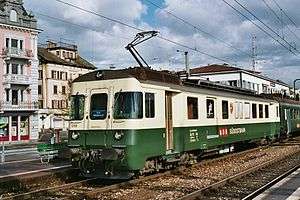Motor coach (rail)
A motor coach (International usage) or motorcar (US usage) is a powered rail vehicle able to pull several trailers and at the same time transport passengers or luggage.[1][2] With multiple unit train control, one operator can control several "motor coaches", possibly even combined with locomotives, efficiently in the same train, making longer trains possible. A motor coach is distinguished from a railcar or railbus by not being lightweight.

Motor coaches can replace locomotives at the head of local passenger or freight trains. Especially electrified narrow gauge lines on the European continent often saw this form of operation. Many of these railways closed down, many others changed to electric multiple units. But a few lines in Switzerland, Italy and Austria still work with train consists hauled by motor coaches. It can be expected that the Bernina line of Rhaetian Railway will continue for a long time to be operated with motor coaches pulling passenger and freight trains.
 A old SiTB motor coach pulling four coaches: not an EMU and not a railcar
A old SiTB motor coach pulling four coaches: not an EMU and not a railcar Two motor coaches of Rhaetian Railway pulling the maximum allowed load of 140 t on the Bernina line
Two motor coaches of Rhaetian Railway pulling the maximum allowed load of 140 t on the Bernina line Electric motor coach with trailer in Switzerland
Electric motor coach with trailer in Switzerland Metre-gauge electric twin motor coach ABDe 8/8 Serie 4000 of the MOB in Switzerland
Metre-gauge electric twin motor coach ABDe 8/8 Serie 4000 of the MOB in Switzerland Soviet motor coach AS1A at Museum of the Moscow Railway (Moscow Rizhsky station)
Soviet motor coach AS1A at Museum of the Moscow Railway (Moscow Rizhsky station)
See also
| Wikimedia Commons has media related to Multiple units, motor coaches and railcars. |
Categories
- Railcar
- Railbus
- Multiple Unit
- Locomotive
General
- Autorail
- British Rail Railbuses
References
- Ellis 2006, p. 222.
- Jackson 2006, p. 216.
Literature
- Ellis, Iain (2006). Ellis' British Railway Engineering Encyclopaedia. Lulu. ISBN 978-1-84728-643-7.
- Jackson, Alan A. (2006). The Railway Dictionary, 4th ed., Sutton Publishing, Stroud. ISBN 0-7509-4218-5.